
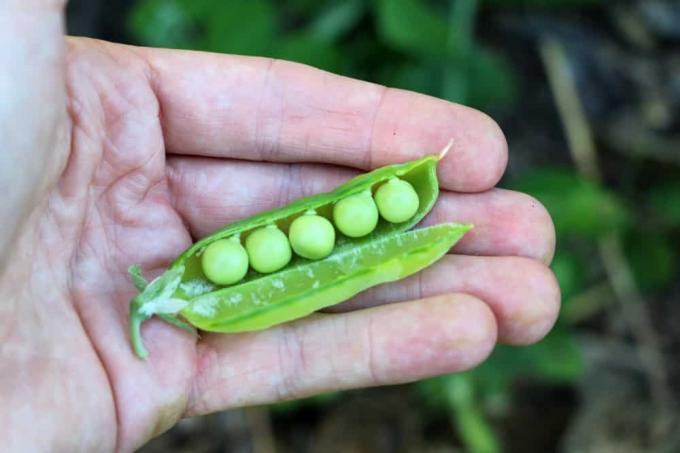
Table of contents
- Selection of peas
- location and soil
- vessels and climbing aids
- sowing
- Care
- harvest
- diseases and pests
Fresh, crunchy and healthy - peas are one of the most popular vegetables in our latitudes, which enrich every garden kitchen. As a rule, cultivation takes place over a large area in the garden; but the cultivation of the delicious pods can also be worthwhile on the balcony. Anyone who creates optimal space conditions, chooses the variety cleverly and takes good care of the vegetables will also look good on the balcony or the terrace can look forward to the harvest - perhaps not for freezing, but for fresh consumption enough.
Selection of peas
If you want to grow peas on the balcony, you should first choose a suitable variety of the green vegetable; Basically, three different variants are distinguished from each other:
- the shell pea
- the wrinkled pea
- the sweet pea
The shell peas are starchy and floury; they are eaten at an early stage and are excellent for drying and re-swelling. For this reason, the pea is often used as a classic ingredient for stews and soups. However, for reasons of space, it is often not possible to grow such large quantities on the balcony in order to cook several soup dishes from the harvest. The same applies to wrinkled peas, which taste a little sweeter than string peas and cannot be dried.
Sugar snap peas are particularly suitable for growing on the balcony, as they can be eaten in their entirety. In addition, they are often used as a savory ingredient in various (mostly Asian) dishes and not “wasted” in large quantities. Last but not least, the cultivation of these sugar-sweet peas is particularly worthwhile because the fresh produce is very expensive in the supermarket.
location and soil
Regardless of which type of pea is grown, the vegetable is generally very adaptable and robust. On the balcony, the chosen location should have the following characteristics:
- as sunny as possible
- partial shade is also tolerated
- as close as possible to the wall of the house
The proximity of the vegetable plant to a wall offers several advantages at once; since cramped conditions usually prevail on the balcony and the hobby gardener with the available standing space must be carefully managed, this location can make full use of the free space contribute. The pea plant climbs upwards and doesn't take up much space on the house wall.
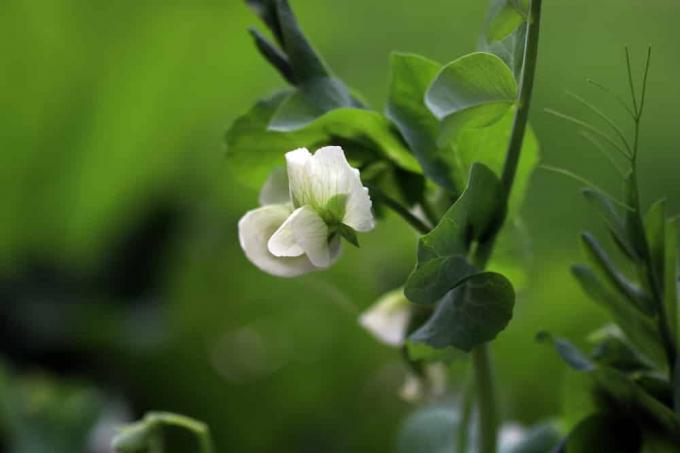
In addition, the wall acts as an extra support when the pea plants grow up; because it can happen that the tendrils slip off their own support structure. Last but not least, the heat is optimally stored on the house wall, so that the peas always enjoy sufficiently high temperatures. In addition to the choice of location, the substrate used for planting the peas also plays a role in ensuring a rich harvest. The earth should have certain characteristics:
- pH between 6 and 7.5
- humorous
- rich in lime and potash salts
- profound
- not too hard
vessels and climbing aids
Peas that are planted on the balcony need suitable containers in which the substrate is filled. If you want to place the vegetables on a house wall, you should opt for a particularly long flower box, which must be very deep. In this way a long row of peas can be grown along the wall of the house. If you plant the peas in the middle of the balcony, you can also switch to a pot or tub; It is important that the planter is of a certain size, as later on there must be enough space between the individual seeds - about 5 cm. In addition, a suitable climbing aid is required for the cultivation of peas on the balcony. The following options are available for optimally supporting the plants:
- thin wooden sticks to which young plants are tied
- chicken wire
- small metal grid
sowing
Once the container has been filled with soil, sowing can take place. It has proven useful to soak the peas in lukewarm water before sowing. Ideally, the grains are then left to stand overnight before sowing can begin the following day. Different sowing dates apply to the different types of peas:
- Pale peas: from mid-March
- Sugar snap peas: from the end of March
- Wrinkled Peas: Early April
- late varieties: in May
Sown in the balcony box, the seeds are placed in a row in the ground. A distance of five centimeters must be maintained between the individual peas. The seed is ideally planted about 5cm deep in the substrate, after which careful pressing is required. Only one row of peas should ever be sown in a window box; however, various mixed vegetables can be grown before the seed in order to make optimal use of the remaining space in the planter.
Tip:
In particular, a row of lettuce, which ideally is laid out as a seed band, is a useful addition to the pea seed.

The combination with other well-tolerated vegetables also ensures less susceptibility to fungi. Sowing another row of peas is not advisable, as there is not enough space in the flower box between the two rows. After sowing, it can make sense to cover the seeds with wide-meshed nets to protect them from bird damage. As the peas grow, the cover must then be removed again.
Care
The care of the pea plants includes piling up soil:
- when reaching a height growth of 10cm
- Earth is piled up around the planting site
- this increases the stability
- Earth is also poured over the roots
The care of the pea plants also includes regular watering; However, the individual portions of water must not be too large, as there is a risk of plant death if overwatered. If it rains continuously, the plant should therefore be pulled under the canopy of the balcony.
In addition to optimal watering of the peas, the targeted supply of nutrients also plays a special role in enabling the plants to grow well. Chemical fertilization is not advisable - for both health and taste reasons. Alternatively, the following options for nutrient supply are available:
- organic liquid fertilizers
- rock flour
- nettle broth
Note: Fertilizers in the form of pellets or grains should generally be avoided when growing in balcony containers, as these usually only degrade slowly. The small amount of substrate could mean that the fertilizer cannot decompose and spread optimally - mold is the result.
Care of the peas also includes loosening the soil, which should be done occasionally. This will prevent any weeds from spreading.
harvest
The optimal time to harvest the balcony peas depends on the type of vegetable:
- Shell peas are ready to harvest at the end of May
- Shell peas can be harvested either young or mature
- Garden peas are harvested from June
- Sugar snaps are ready to harvest from June and are picked as tender, young pods
In order to be able to determine the optimal time at which the pods can be harvested, the weather should also be taken into account. It is also advisable to examine the peas individually to find out the degree of ripeness. If the peas can already be felt clearly in the pods, they are ripe. Most of the time, the grains still taste particularly tender and sweet.
If, on the other hand, the peas are clearly visible under the pods, the optimal harvest time has usually been exceeded - the pods lose their taste and quality.
Sugar snap peas in particular can then become bitter very quickly. With this type of pea in particular, constant picking is advisable in order to always get the optimum degree of ripeness.
Exceeding the maturity level can be recognized by the following characteristics:
- mealy taste
- bitter aftertaste
- particularly hard consistency
- increasing toughness
Tip:
Wrinkled peas should still be green when harvested; Sugar peas are already ready to harvest when the first signs of the grains appear under the pod.
The harvest that can be expected from the balcony garden is usually not as plentiful as with outdoor vegetables. However, if you have picked a larger portion of peas and cannot eat them immediately, it is best to store the vegetables in the refrigerator. But even with optimal cooling, the peas can be kept for a maximum of three days. If frozen, the shelf life is extended by several months.
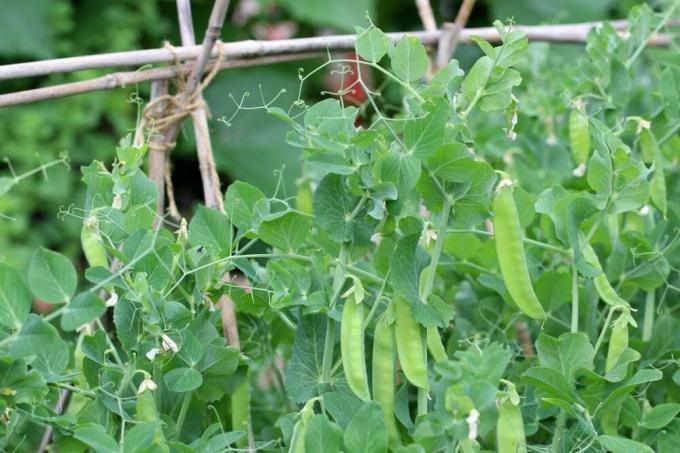
After harvesting, the pea tendrils should be cut off close to the ground. It has proven useful to leave the subterranean parts in the ground for a while, as the roots enrich the substrate with nitrogen. This natural fertilizer conditions the soil - optimal for subsequent sowing of nutrient-loving vegetables, which take place in early summer. In this way, the capacities on the balcony are optimally utilized.
diseases and pests
A dreaded disease in the pea plant is powdery mildew, which is shown by the following damage pattern:
- initially white leaf covering
- Coatings later turn grey-brown
- browning of the pods
- crippling of the entire plant
Be careful on the balcony, especially on warm summer days when the heat builds up; then the fungal disease spreads. Sulfur-containing fungicides can provide a quick remedy. On the balcony, various care mistakes can also pose a danger to the pea plants - especially if too little substrate is used when cultivating the plants.
Peas belong to the medium-deep roots and need sufficient soil to thrive - and therefore the deepest possible balcony boxes with a large volume. Otherwise, nutrient deficiencies can quickly occur, which is expressed in the yellowing of the plant parts.
In addition to classic plant diseases, pests can also be dangerous for peas. Which includes:
- pea moth
- pea beetle
- Pea leaf edge beetle
In the event of an infestation with pests, caution is always required; these should never be treated with a strong fungicide as the peas are intended for consumption and breakdown products from chemical products can build up in the vegetables. The use of natural enemies, such as parasitic wasps and ladybirds, is more suitable. Due to the cramped conditions on the balcony, it is essential to ensure that the pea plants are not too close together and that the minimum distance is maintained in any case.
Otherwise, diseases and pests can spread quickly and destroy the entire crop. Overall, however, growing peas on the balcony has proven itself. Anyone who pays attention to the special circumstances that require a cultivation of the popular and healthy fruit in a small space brings great joy to the crunchy vegetables - and can spice up one or the other dish with them!
 garden editorial
garden editorial I write about everything that interests me in my garden.
Learn more about maintaining a vegetable garden

Make a climbing aid for cucumbers yourself: building instructions
Cucumbers are healthy, tasty and versatile. In order for the cultivation in your own garden to be successful, you should offer the cucumber tendril, which likes to climb, optimal conditions. The easiest way to do this is with a cucumber trellis, which you can quickly and easily build yourself with our instructions.

Pricking out vegetables: Information for vegetable plants such as spinach, corn & Co
Many gardeners prefer their vegetables on the windowsill or in the greenhouse in the spring. After some time, the seedlings must be isolated by pricking out. This measure is essential for their survival so that they can develop healthily and vigorously.

Growing vegetables in the garden – which vegetables to plant next to each other?
Today, even a hobby gardener knows: With the right neighbors, vegetable plants develop particularly well in mixed cultures. You can even defend yourself against pests together. In this article we have put together for you which types of vegetables go well together and which go poorly together.
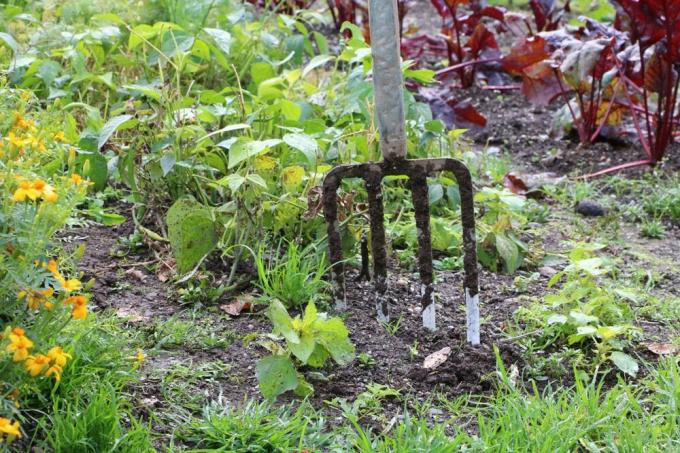
What is a mixed culture? Examples with table from the garden
Ornamental and crop plants of different species and genera form alliances to defend themselves against attacks by diseases and pests. Clever home gardeners take advantage of this strategy and cultivate their vegetables in mixed cultures. You can read here what exactly is behind this technical term. Field-tested examples from the garden clarify the connections.

Sowing calendar for vegetables - when to sow which vegetables?
With so many different types of vegetables, it is not easy to find the right time for sowing. Finally, the appointment differs depending on the species. In addition, of course, it also makes a difference whether the vegetables are pre-cultivated in the house, cold frame or greenhouse or sown straight into the field.
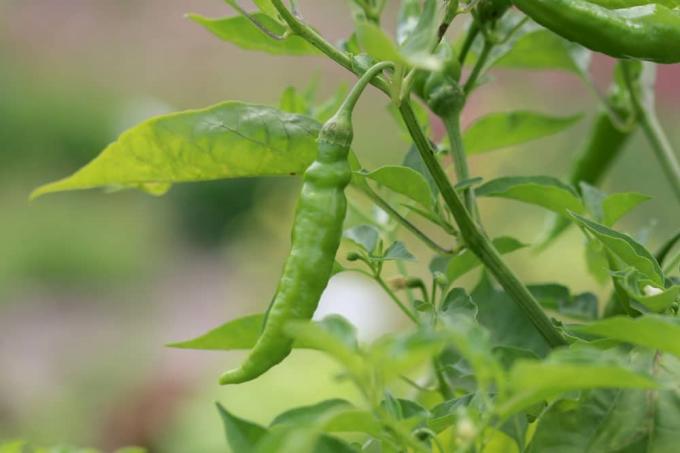
Growing pepperoni plants from seed - instructions to harvest
The cultivation of the crunchy peppers is extremely popular among many hobby gardeners. rightly so! - Because the colorful fruits of the pepperoni plants not only beautify the vegetable patch, but are also extremely tasty. If you also prefer rare or special types of pepper, you can prefer them yourself with a comparatively small amount of work.



